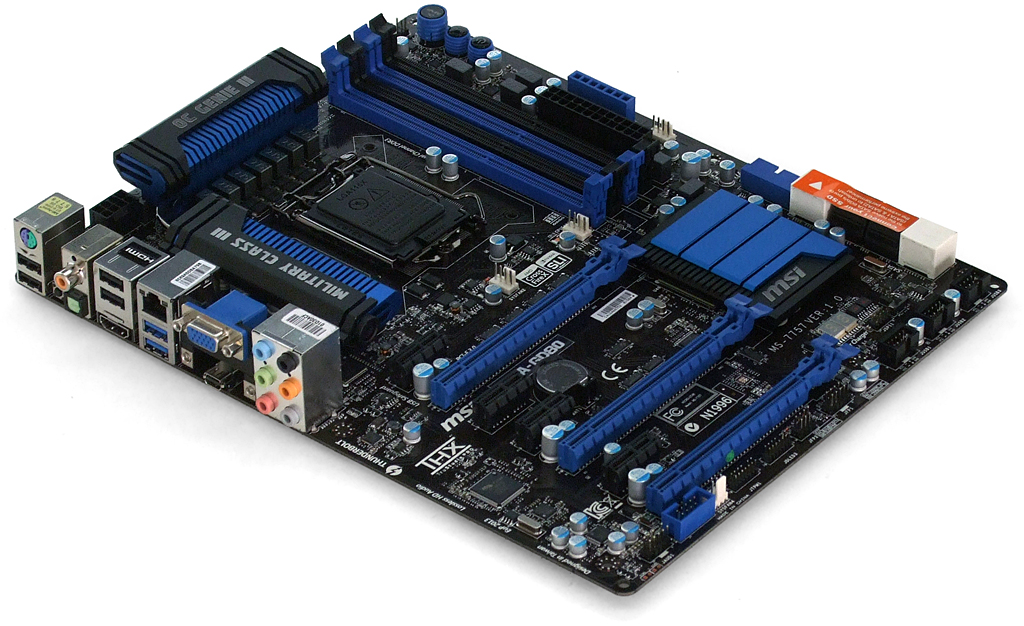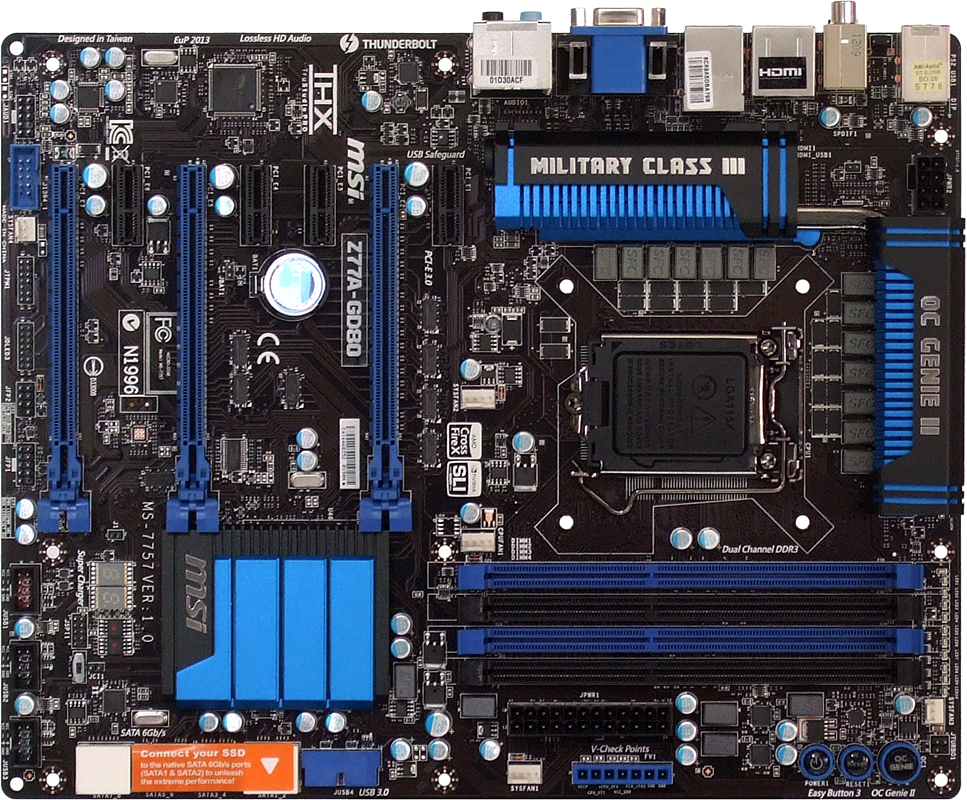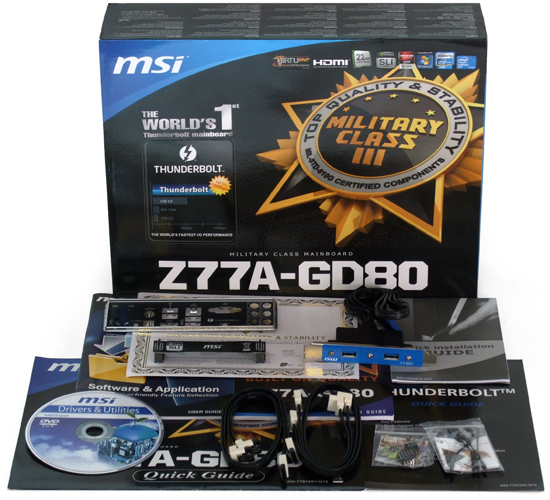Six $220-280 Z77 Express-Based Motherboards, Reviewed
Expanded graphics card support, enhanced on-board features that include Thunderbolt on some models, and more-robust voltage control are all good reasons to consider paying a little extra for a higher-end motherboard. Today we examine five top choices.
MSI Z77A-GD80
With a single Thunderbolt port and no PCIe bridge to facilitate lane sharing, the best way for MSI to beat Intel is on price. It’s no wonder, then, that the Z77A-GD80 is $35 cheaper than Intel's DZ77RE-75K.
Anyone interested in the Z77A-GD80 gets two fewer back-panel USB 3.0 ports, but more audio connectivity compared to MSI’s most closely-matched rival, Intel. We also find a third PCIe graphics slot, which could be the deciding factor for many buyers.
A quick look at the PCIe switches tells us that the Z77A-GD80 goes from x16/x0/x0 mode to x8/x8/x0 when a card is installed in the second x16-length slot, and then to x8/x4/x4 mode when a third graphics card is added. A quick check of the motherboard manual confirms our observation. Though this is the only way to natively support three graphics cards from the Ivy Bridge processor’s on-die PCI Express controller, the same configuration is not available if you have a Sandy Bridge-based processor installed. The newer CPU supports three devices, while the older CPU supported only two.
MSI uses a forward-facing USB 3.0 internal header to fit that big and inflexible cable underneath any long expansion cards. Most cases that support forward-facing SATA cables will have no problem with the forward-facing USB 3.0 ports.
The Z77A-GD80 also includes two added-in SATA 6Gb/s ports via a third-party PCIe-based controller. That controller sits on the same PCIe 2.0 lane as FireWire, however, and you have to pick the device you want enabled through MSI's firmware.
You're faced with the same conundrum if you have multiple PCI Express x1 cards, since the four slots sit on only two lanes. Choosing between slots one and two should be easy since the second x1 slot is usually blocked by the graphics card anyway, and an SLI configuration would make the same choice between x1 slots three and four just as easy. MSI could have simply left out x1 slots two and four to save a few cents, except that enthusiasts are more likely to notice blank spaces on the motherboard before they realize two of those slots won't work at any given time, disingenuous as that may be.
Overclocking exhibitionists will like the Z77A-GD80’s on-board Port 80 diagnostics display, enough though its location could be covered by a second graphics card. A row of voltage detection points, power, and reset buttons are similarly valuable, and fortunately less likely to get covered up.
Get Tom's Hardware's best news and in-depth reviews, straight to your inbox.
The Z77A-GD80 includes four SATA cables, a set of voltage check-point adapter wires, a USB 3.0 slot panel adapter, and a single SLI bridge.
-
roberta As u have reviewed SIX (6) motherboards, the article's title should be:Reply
"Six $220-280 Z77 Express-Based Motherboards, Reviewed" -
mayankleoboy1 No SATA and USB tests ? data transfer speed differences will typically be noticable in everyday usage.Reply
Also, the time taken to show the windows loading screen/ BIOS page.. -
admit it.Reply
you really liked the black/grey dimms and PCI slots of the gigabyte better than the blue/black of the MSI! -
Crashman robertaAs u have reviewed SIX (6) motherboards, the article's title should be:"Six $220-280 Z77 Express-Based Motherboards, Reviewed"Let's see what the article says:ReplyThe one motherboard in today’s line-up with a 48-lane PCIe 3.0 bridge is ECS’ Golden Z77H2-AX. Unfortunately, this platform climbed $40 beyond the budget limit of today’s round-up in the time we've been reviewing it. We're tired of seeing board vendors playing pricing games based on our review schedule (this isn't the first time we're seeing a curiously-timed price move). So, since we put the work in to review ECS' submission, we're including our already-gathered data and simply withholding the board from any award candidacy.
mayankleoboy1No SATA and USB tests ? data transfer speed differences will typically be noticable in everyday usage.Also, the time taken to show the windows loading screen/ BIOS page..Would have covered windows load time except that it wasn't markedly different. That is, after disabling empty SATA controllers. If you count the time that it takes to get the "No Device Found" error on boards that have extra SATA controllers, you're penalizing a board for having more features.
Andrew Ku tests drive controllers. I'm trying to get him to "write the book" on controller performance, since dozens of boards use only a few different controllers. As for testing things like Z77 controller performance on board A vs Z77 controller performance on board B, it's a waste of time unless something is broken. So the article looked for "broken stuff". See the red bar on the first chart:
http://www.tomshardware.com/reviews/z77x-up5-th-z77a-gd80-z77-oc-formula,3305-22.html
With nothing broken, there's no excuse to test the Z77 controller six times. Back to me begging Andrew Ku for a comprehensive comparison of every SATA controller currently available on mainstream-brand enthusiast boards.
-
JeanLuc Arghh! Why the hell are you overclocking the base clock on Z77!! That will most likely cause permanent damage to your CPU.Reply -
You left out a key aspect for overclockers which is vcore offset.Reply
This allows ocer's to achieve higher overclocks while still retaining the power saving functions, instead of being forced to either reduce the overclock, or be forced to run high voltage 24/7.
MSI doesn't have this key feature. -
Onus I would think that the Sabertooth's five year warranty merits at least a mention in any value conclusion.Reply
-
luciferano JeanLucArghh! Why the hell are you overclocking the base clock on Z77!! That will most likely cause permanent damage to your CPU.Reply
Overclocking the BLCK is very unlikely to cause any damage, it's just likely to not give much of a stable overclock. -
Crashman jtt283I would think that the Sabertooth's five year warranty merits at least a mention in any value conclusion.I actually missed that, having checked the lesser brands just to make sure those still had their three year warranty. Will add it.Reply



